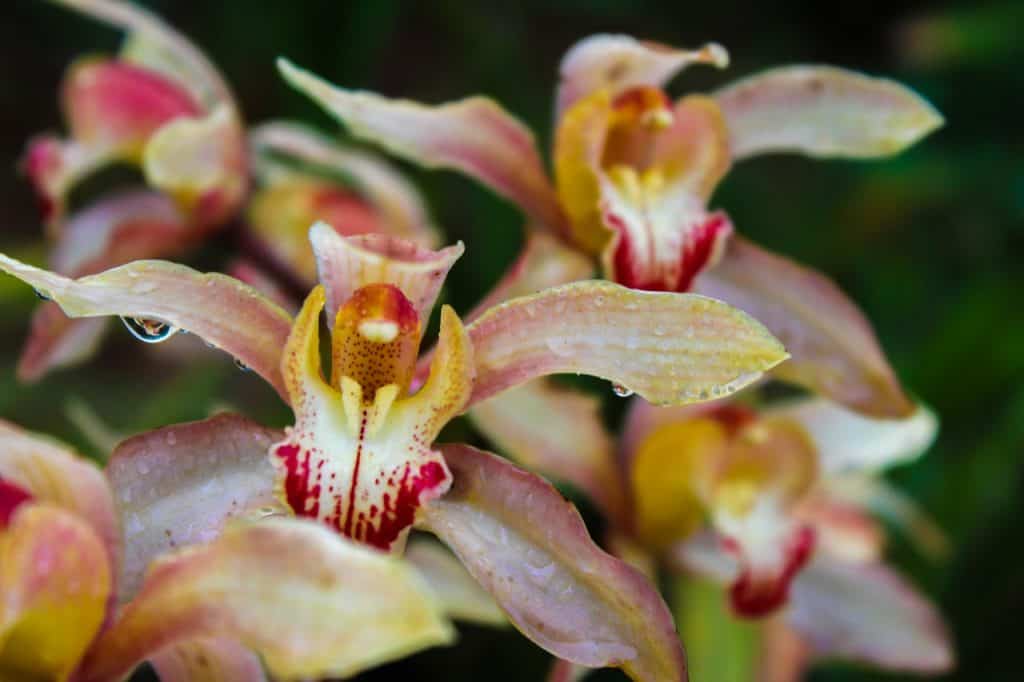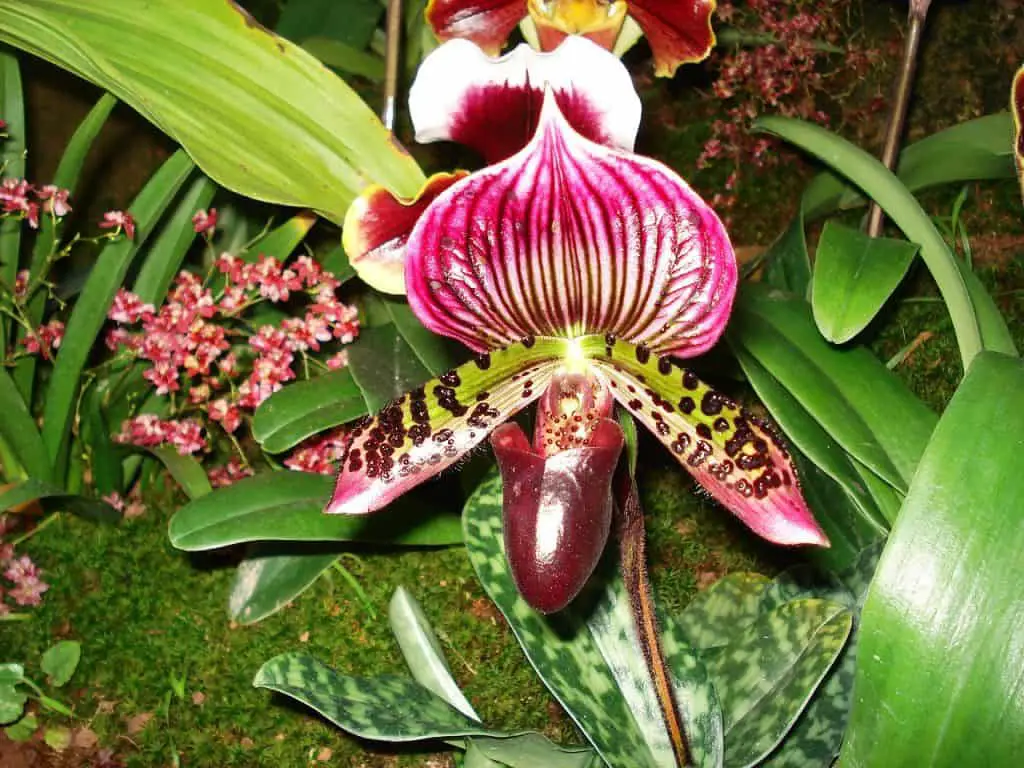How Do I Care for Indoor Orchids (Including Phalaenopsis Orchid Care)
You’ve obviously arrived on this webpage because you’re asking the question: “How do I care for my indoor orchids?”
Perhaps you’ve attempted to keep orchids before and perhaps that attempt ended in failure – your orchids perished, for one reason or another.

On the other hand, it could be that orchids are a new phenomenon to you and you have little idea what to do with these beautiful plants.
Either way, by reading this easy-care orchid guide, you’ll understand how orchid care works.
(This post may contain links to products. Please make the assumption that at least some of the links may result in earning commissions. Thank you.)
How Do I Care for Indoor Orchids – How to Water Your Orchids
Orchids do not like to sit in water.
The amount you water your orchids depends on how much the plant actually needs.
This is correlated to the amount of light the orchid receives, the amount of humidity, and what type of container the orchid’s roots are in.
For Cattleya and Phalaenopsis orchids – two of the most popular types of indoor orchid, you should water just prior to the root space becoming dry.
Phalaenopsis by Dominika Roseclay from Pexels
How do you know when that is?
Well, it’s dependent on the type of orchid, as well as, as has been mentioned, the growing conditions within the room where the orchid is.
It is also dependent – very much dependent – on the medium in which the roots are growing.
So, to get back to the question: How do you know when the plant needs water?
Stick your finger into the growing medium.
You’ll then be able to determine if the medium is dry, moist, soaking, or whatever.
If the medium is dry, you know you should provide your orchid with water.
What’s more, over time, by lifting the pot in which your orchid is growing, you can gain a sense of how heavy it is.
And you’ll then gain a sense of whether the plant requires water.
What sort of water should you use for indoor orchids?
Tap water is fine. Rainwater is good. Distilled water is not suitable.
There are many suppliers that sell orchids in opaque plastic pots that you can see the roots through.
If the growing media is bark or moss – both of which are a very attractive growing medium for orchids – and it’s moist, you’ll be able to see that there’s some condensation on the interior surface of the pot.
On the contrary, when the media is dry, there will be zero condensation.
You’ll then know it’s the right time to provide the plant with some water.
And when you do water your orchid, all you need to do is to pour the water into the pot and allow the excess to drain.
It’s not at all wise to allow your orchids to grow in pots that have no drainage holes in the base.
If your orchid’s pot has zero drainage holes, you should re-pot it into a vessel that has holes in the base.
Either that or you may be able to drill some holes into the pot yourself.
Opaque Plastic Pots for Orchids
How to Care for Indoor Orchids – Using the Right Potting Mix for Orchids

Usually, orchids come in either bark or moss as the growing media.
Both are perfect.
Nevertheless, they are both very different.
As such, they call for different caring procedures.
Bark doesn’t hold onto water.
As such, it comes with less risk than moss in that it’s never (or should never be) moist.
Moss, on the other hand, holds onto water, much like a sponge does.
It takes far longer to dry out than bark.
For orchids such as Cattleya and Phalaenopsis – both of which need to be thoroughly dry around the root base before watering takes place – if the growing medium is moss, you should be careful not to water too frequently.
There’s a rule of thumb with indoor orchids, regardless that they are growing in bark or in moss: One day prior to the medium being completely dry is the time to provide your orchid/s with water.
When it comes to nun’s orchids (Phaius tankervilleae) and lady slipper (Cypripedium species), both of these species enjoy moist growing conditions.
Because of this, moss is ideal.
100% Organic Better Gro Orchid Moss
That said, both varieties can also be grown in bark though the bark should be fine-textured.
If nun and/ or lady slipper orchids are growing in bark, they need to be watered that much more often than if they were growing in moss.
Arguably, the best of both worlds – a bark/ moss blend – is, well… best for orchids.
Here’s a lovely blend of bark and moss that is suited to all indoor orchid species, not just to Phalaenopsis…
Phalaenopsis Imperial Orchid Mix – AAA Gold
What to Feed Your Orchids?
Everyone who loves indoor (and outdoor) plants loves MiracleGro, don’t we? So in this case, a good MiracleGro feed for orchids is Miracle-Gro 1001991 Water Soluble Orchid Food. Make an application every couple of weeks during the growing season and once every four weeks in the dormant season for best results.
Nitrogen-Phosphorus-Potassium ratio of this orchid food? 30-10-10.
Miracle-Gro 1001991 Water Soluble Orchid Food
How to Re-pot Orchids

1. First, remove any dead roots prior to repotting.
The media that orchids grow in – bark or moss – has a tendency for decomposing quite rapidly – particularly bark.
When either medium does decompose, they lose the capacity for relatively quick drainage – again, particularly with regards to bark.
If growing in bark, orchids should be repotted once every year or every second year.
The bark to be replaced should be removed and added to your garden composter.
Any dead roots should be cut off.
2. Ideally, you should place your orchid in a pot that is a little bit larger than the pot it was growing in.
Then add in the fresh bark.
Whenever you water, it’s good practice to add in a water-soluble fertilizer – at quarter strength.
Quarter strength simply means that whatever it says on the label of the fertilizer – whatever amount is the recommended amount for mixing with water – use only a quarter of this amount.
Light for Your Orchid

Orchids that have a preference for relatively low levels of light will do better in your home than those that need more light.
A windowsill that is east facing is a good place for an orchid.
If placed on a windowsill that is south facing, it can actually be too bright, and also a bit hot when the sun is shining during the summer months.
You can get around this, though, by hanging a sheer curtain to provide some light and heat filtering.
Either that, or you can set your orchid away from direct light in the south-facing window so that it does not sit in strong, direct sunlight.
A west-facing window will possibly be too hot for many orchid varieties.
Again, though, you can filter the light on a west-facing window, just as you would with a south-facing window.
North-facing windows are not bright enough.
For orchids that are in bloom, you might wish to place them as a centerpiece on a dining room table, or someplace else – someplace that is not really bright enough for the health of the plant.
That’s fine, though. Just be sure to return your orchid to its window of preference once the blooms are finished.
How Much Humidity Does an Orchid Need?

Orchids that are suited to the home do not need the same amount of humidity they would get from their natural habitat – the rainforest. No doubt that comes as some relief.
That said, if the room where your orchid/s is/ are is air-conditioned, the dry atmosphere can pose a challenge for any orchid.
This is why you should provide your orchids with a daily misting.
Either that or you can place your orchids on top of a bed of gravel that is persistently moist.
If you do place your orchids on top of moist gravel, make sure they are not sitting in water.
An orchid sitting in water will saturate the roots, and your plants will not be happy about that.
You can also get orchid humidity trays. Not quite as attractive as beautifully colored gravel but still very effective for providing humidity.
How to Get Your Orchids to Re-flower
Orchid blooms will eventually fade, just as they do on any plant.
But that’s never a reason to ditch an orchid. It will, given the right conditions, re-flower over and over again.
To explain how to get your orchids to re-flower, again and again, have a look at the following video:
How to Care for Indoor Orchids – Which Orchids Are Easiest for a Novice?
There are four types of orchid that stand out in terms of being suited to those of us that want true simplicity in terms of caring for the orchids in our homes:
- nun’s orchids (Phaius tankervilleae)
- lady slipper orchids (Paphiopedilum species)
If you have been able to successfully culture a pothos – otherwise known as devil’s ivy – which is very easy to care for, then you’ll likely be successful with any of the above-named orchids. Even if you haven’t got much indoor plant-growing experience, the two orchids above (and the two orchids below) are still relatively easy to care for.
Both of the two orchids above love moisture.
That’s an important aspect of growing orchids in the home because over-watering is the most common problem when it comes to a dying orchid.
- Phalaenopsis (moth orchid)
- Cattleya hybrids (‘corsage’ orchid)
These two varieties prefer their roots to be dry.
This means that they are very vulnerable to too much ‘love’ by those that believe that regularly watering their plants is a good thing.
Otherwise, though, and these two orchids, the Phalaenopsis and many Cattleya hybrids, are easy to keep.
- Cymbidium
Cymbidiums take kindly to short days of brightness.

They flower well in northern winters due to the shortness of daylight hours.
In the south, cymbidiums are not so easy to get to bloom because the winter daylight hours are longer than in the north.
If you’re in the U.K., you may want to know which orchids grow outdoors in the U.K.






